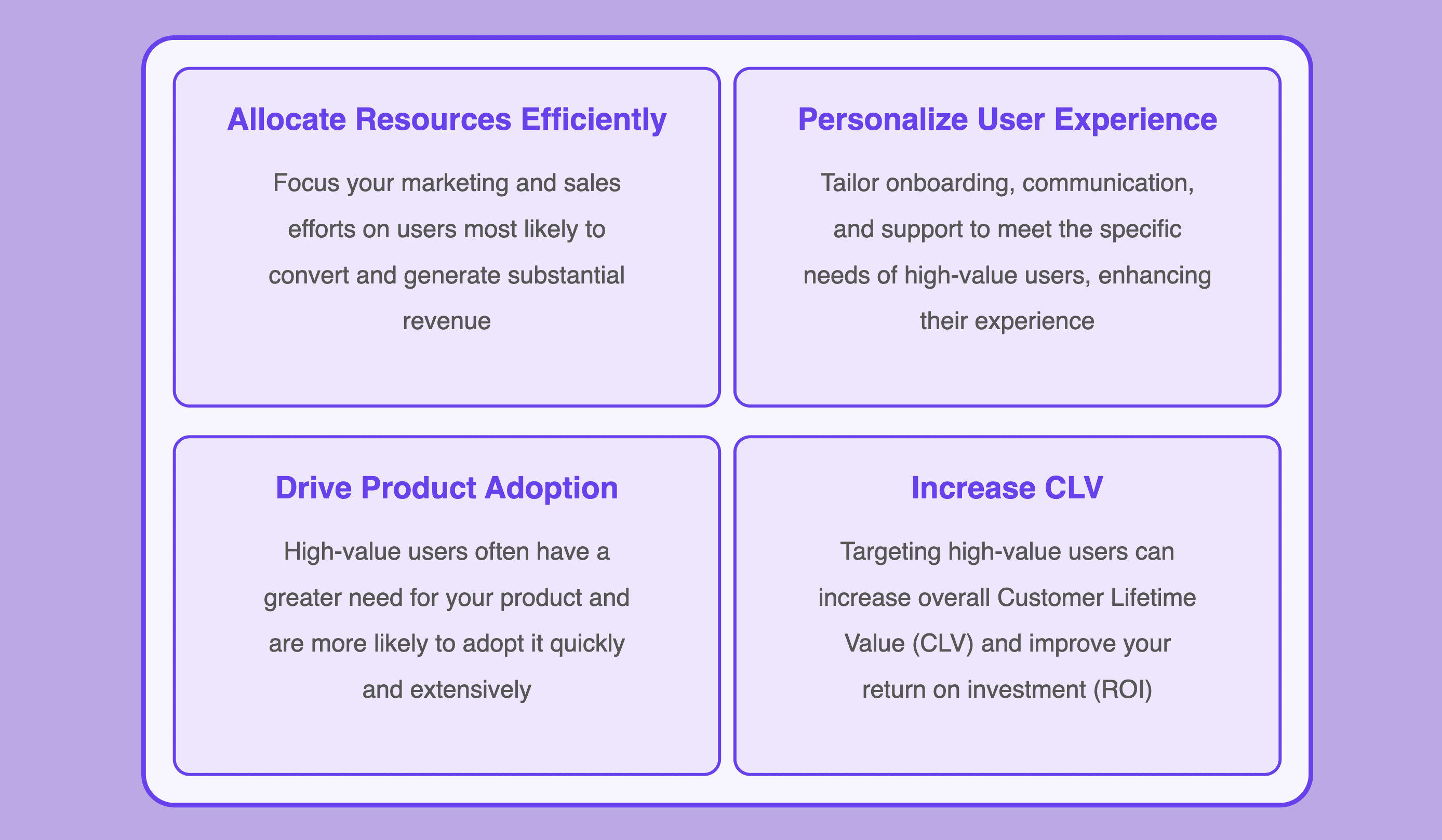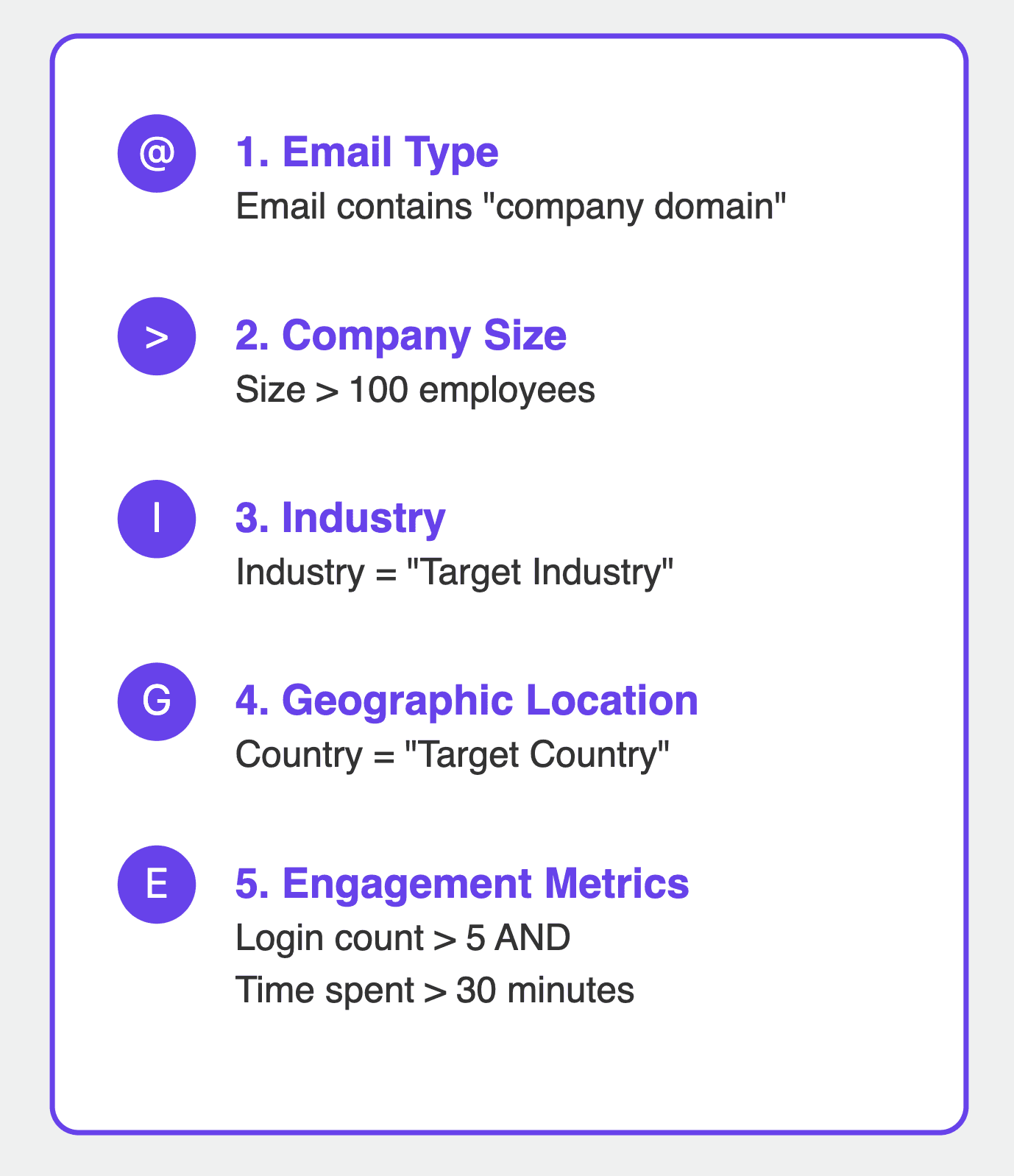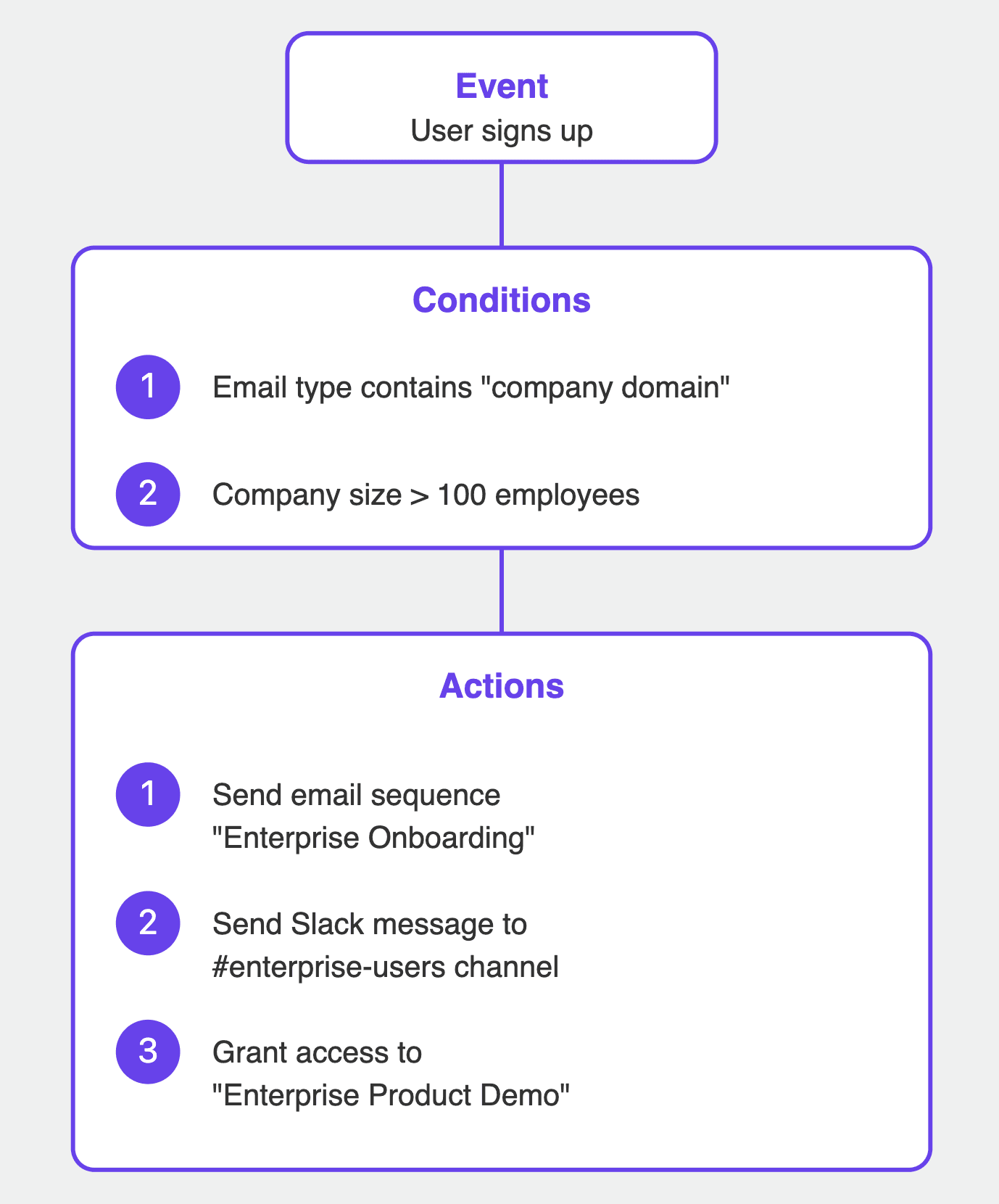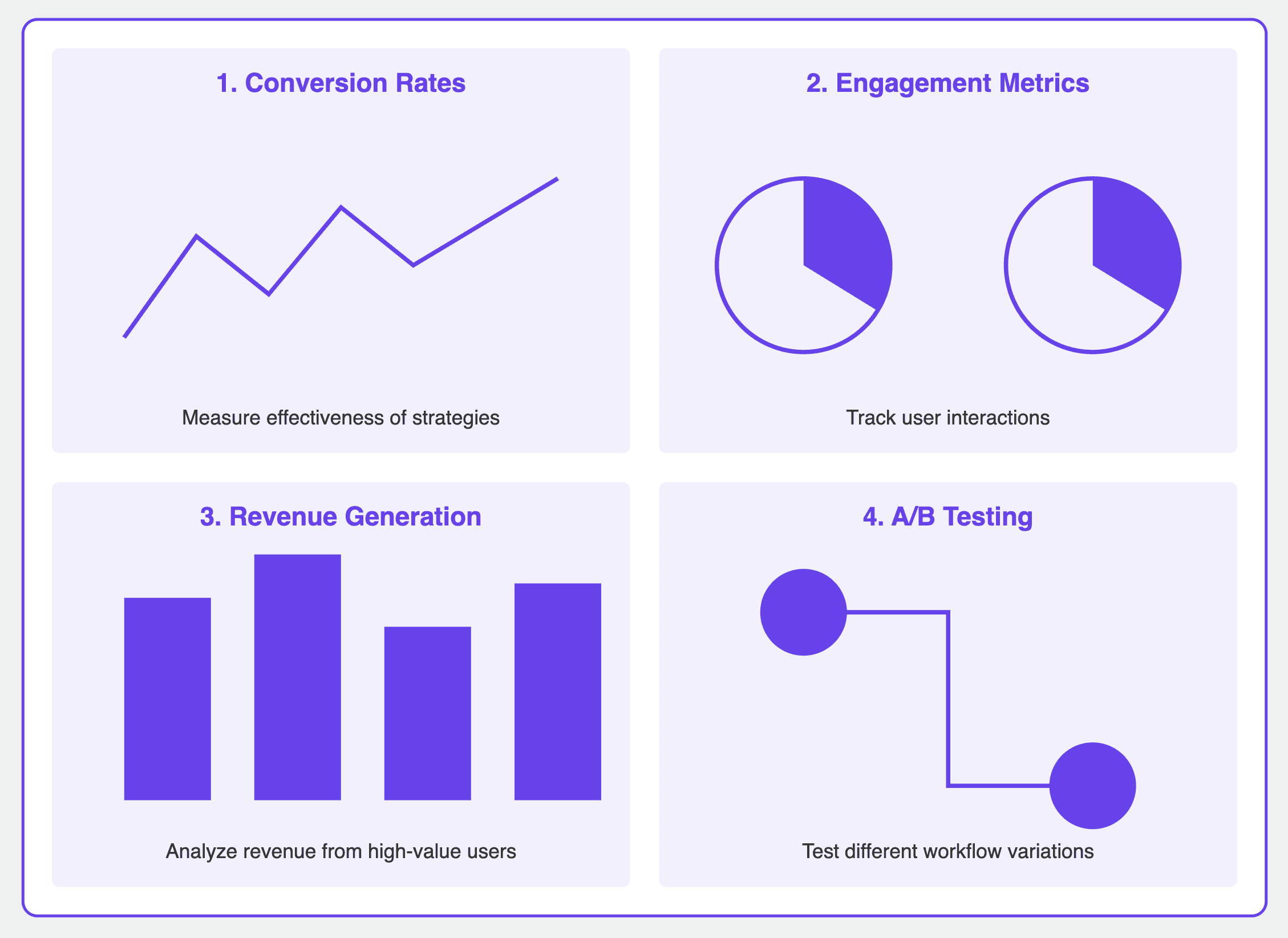
Identifying High-Value Users Within Signups for PLG SaaS

by
Aleksa Mitrovic
Sep 24, 2024
Identify and convert your most valuable users
Sign Up
Identifying high-value users among your signups is a critical step in optimizing your marketing efforts and accelerating growth.
High-value users are those who are most likely to convert, engage deeply with your product, and ultimately drive significant revenue.
By leveraging user and company attributes, you can pinpoint these users and tailor your strategies to maximize their potential. This detailed blog post will guide you through the process of identifying high-value users and introduce you to the powerful feature of Automated Workflows.
The Importance of Identifying High-Value Users

Identifying high-value users early in their journey allows you to:
Allocate Resources Efficiently: Focus your marketing and sales efforts on users who are most likely to convert and generate substantial revenue.
Personalize the User Experience: Tailor your onboarding, communication, and support to meet the specific needs of high-value users, enhancing their experience and increasing the likelihood of conversion.
Drive Product Adoption: High-value users often have a greater need for your product and are more likely to adopt it quickly and extensively.
Increase Customer Lifetime Value (CLV): By targeting high-value users, you can increase the overall CLV and improve your return on investment (ROI).
Leveraging Automated Workflows
Automated Workflows is a robust feature that enables you to automate your lifecycle marketing efforts. With this tool, you can send targeted omnichannel messages to users at the right time, enhancing their journey and increasing the likelihood of conversion. Here's how Automated Workflows can help you target high-value users:
Event-Based Triggers: Set up workflows that initiate based on specific events, such as a new user signing up, a user activating their account, or a user demonstrating high engagement.
Conditional Logic: Apply conditions to refine your target audience based on user and company attributes. This ensures that your marketing efforts are focused on high-value users.
Personalized Actions: Define actions that cater to the needs of high-value users, such as sending personalized emails, triggering in-app messages, or notifying your sales team.
Creating a Simple Workflow to Target High-Value Users
Let's create a simple workflow together to illustrate how you can target high-value users effectively.
Step 1: Select an Event to Start the Workflow
Choose an event that will initiate the workflow. For instance, you can use:
New user signup
User activation (i.e., the user has experienced the value of your product)
High engagement (e.g., the user has logged in multiple times or used key features)
In our case, we'll focus on activated users who have experienced the value of your product but are not yet converted.
Step 2: Add Conditions to Refine Your Target Audience

If necessary, add conditions to further refine your target audience. Conditions can be based on various attributes, such as:
Email Type: Target users with professional email addresses, as they are more likely to be part of a company and have a higher potential for conversion.
Condition: Email type contains "company domain"
Company Size: Larger companies often have bigger budgets and more extensive needs. Targeting users from larger companies can lead to higher-value conversions.
Condition: Company size > 100 employees
Industry: Certain industries may have a higher demand for your product. Identifying users from these industries can help you focus your marketing efforts more effectively.
Condition: Industry = "Target Industry"
Geographic Location: Users from specific regions may be more likely to convert based on market trends and local demand. Tailoring your marketing to these regions can increase your conversion rates.
Condition: Country = "Target Country"
Engagement Metrics: Look at engagement metrics such as login frequency, feature usage, and time spent on the platform. High engagement often correlates with higher value.
Condition: Login count > 5 AND Time spent > 30 minutes
Step 3: Define Actions That Cater to High-Value Users
Once the conditions are met, define the actions that will be triggered. These actions should be tailored to the needs and preferences of high-value users. Some examples include:
Personalized Email Sequences: Create targeted email campaigns that address the specific needs and pain points of high-value users.
Action: Send email sequence "High-Value User Onboarding"
In-App Messages: Display in-app messages that guide high-value users through your product, highlighting key features and use cases.
Action: Show in-app message "Welcome High-Value User"
Internal Notifications: Alert your sales or customer success team about the new high-value user, enabling them to provide personalized support and outreach.
Action: Send Slack message to #high-value-users channel
Product Tutorials: Offer high-value users exclusive access to product tutorials or webinars that help them get the most out of your product.
Action: Grant access to "Advanced Product Webinar"
Example Workflow: Targeting Professional Users from Large Companies

Let's say you want to target users who sign up with a professional email address and are part of a large company. Here's how you can set up the workflow:
Event: User signs up.
Condition 1: Email type contains "company domain".
Condition 2: Company size > 100 employees.
Action 1: Send email sequence "Enterprise Onboarding".
Action 2: Send Slack message to #enterprise-users channel.
Action 3: Grant access to "Enterprise Product Demo".
By setting up this workflow, you ensure that high-value users from large companies receive personalized communication and support that caters to their needs, increasing the likelihood of conversion.
Monitoring and Optimizing Your Workflows

To maximize the effectiveness of your Automated Workflows, it's essential to monitor their performance and optimize them based on data-driven insights. Here are some key metrics to track:
Conversion Rates: Measure the conversion rates of users who go through your workflows to identify which strategies are most effective.
Engagement Metrics: Track user engagement throughout the workflow, including email open rates, click-through rates, and in-app message interactions.
Revenue Generation: Analyze the revenue generated by high-value users who convert after going through your workflows.
A/B Testing: Continuously test different workflow variations to identify the most effective strategies for targeting high-value users.
Conclusion
Identifying high-value users within your signups is a strategic move that can significantly boost your PLG SaaS growth. By leveraging user and company attributes and utilizing Automated Workflows, you can create targeted and effective marketing campaigns that drive conversions.
Start by defining your conditions and actions, and watch as your high-value users convert into loyal customers.
Stay tuned for more insights on optimizing your PLG SaaS strategies, and happy growing!




